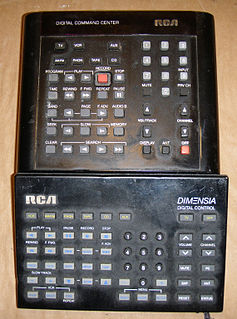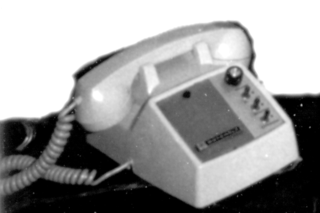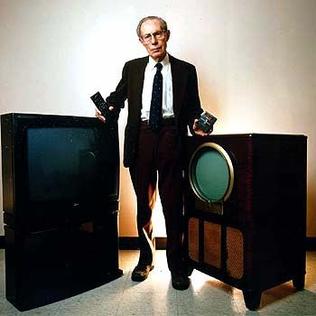 W
WIn electronics, a remote control or clicker is an electronic device used to operate another device from a distance, usually wirelessly. In consumer electronics, a remote control can be used to operate devices such as a television set, DVD player or other home appliance. A remote control can allow operation of devices that are out of convenient reach for direct operation of controls. They function best when used from a short distance. This is primarily a convenience feature for the user. In some cases, remote controls allow a person to operate a device that they otherwise would not be able to reach, as when a garage door opener is triggered from outside.
 W
WThe Apple Remote is a remote control introduced in October 2005 by Apple Inc. for use with a number of its products with infrared capability. It was originally designed to control the Front Row media center program on the iMac G5 and is compatible with many subsequent Macintosh computers. The first three generations of Apple TV used the Apple Remote as their primary control mechanism. It has now been replaced with the Siri Remote in the fourth generation. Prior to the Apple Remote, Apple produced several nameless IR remotes for products such as the Macintosh TV, TV tuner expansion boards, and the PowerCD drive.
 W
WThe Digital Command Center was a very large remote control introduced for RCA's high-end television sets; in 1983 for the Colortrak 2000 and the SJT400 CED player and in 1984 for the Dimensia Lyceum TV sets. The main feature of the Digital Command Center was that it was universal amongst many RCA components, including VCRs, CED players, tuners, amplifiers, CD players, etc., on top of controlling the monitor itself. The Digital Command Center took four AA batteries to power, due to its extensive and ahead-of-its time functionality.
 W
WExtron Electronics, known as Extron, is a manufacturer of professional audiovisual equipment. It is headquartered in Anaheim, California. Extron operates over 30 offices and regional training and demonstration facilities around the globe.
 W
WiTunes Remote is a software application developed by Apple Inc. for iOS devices that allows for remote control of Apple TV or iTunes library in an area with Wi-Fi connectivity using the proprietary Digital Audio Control Protocol (DACP). It is currently available as a free download from the App Store for iOS devices such as iPhone, iPod Touch, iPad, and Apple Watch.
 W
WLogitech Harmony is a line of remote controls and home automation products produced by Logitech. The line includes universal remote products designed for controlling the components of home theater systems and other devices that can be controlled via infrared, as well as newer "Hub" products that can be used to additionally control supported Internet of things (IoT) and Smart home products, and allow the use of mobile apps to control devices.
 W
WThe Netflix button is a button available on many modern remote controllers, used to directly connect to the popular streaming service Netflix. It was initially implemented in America in 2011. In 2015, the button was added to European remotes. This button sends an infrared(IR) signal to the television and opens up the Netflix app. Many popular TV companies have adopted the Netflix button, including: LG, Samsung, and Sony. Some of the TVs have made it to a list that Netflix has dubbed the "Netflix Recommended TVs". These are TVs that have a Netflix button on them which Netflix recommends to their subscribers to get the best viewing experience for their service.
 W
WRemote control animals are animals that are controlled remotely by humans. Some applications require electrodes to be implanted in the animal's nervous system connected to a receiver which is usually carried on the animal's back. The animals are controlled by the use of radio signals. The electrodes do not move the animal directly, as if controlling a robot; rather, they signal a direction or action desired by the human operator and then stimulate the animal's reward centres if the animal complies. These are sometimes called bio-robots or robo-animals. They can be considered to be cyborgs as they combine electronic devices with an organic life form. Because of the surgery required, and the moral and ethical issues involved, there has been criticism aimed at the use of remote control animals, especially regarding animal welfare and animal rights. A similar, non-invasive application has been reported which stimulates the brain with ultrasound to control the animal. Some applications use vibrations or sound to control the movements of the animals.
 W
WAn RF module is a (usually) small electronic device used to transmit and/or receive radio signals between two devices. In an embedded system it is often desirable to communicate with another device wirelessly. This wireless communication may be accomplished through optical communication or through radio-frequency (RF) communication. For many applications, the medium of choice is RF since it does not require line of sight. RF communications incorporate a transmitter and a receiver. They are of various types and ranges. Some can transmit up to 500 feet. RF modules are typically fabricated using RF CMOS technology.
 W
WTeleoperation indicates operation of a system or machine at a distance. It is similar in meaning to the phrase "remote control" but is usually encountered in research, academic and technical environments. It is most commonly associated with robotics and mobile robots but can be applied to a whole range of circumstances in which a device or machine is operated by a person from a distance.
 W
WRemote controls are used any time a two-way radio base station is located away from the desk or office where communication originates. For example, a dispatch center for taxicabs may have an office downtown but have a base station on a distant mountain top. A Tone remote, also known as an EIA Tone remote, is a signaling system used to operate a two-way radio base station by some form of remote control.
 W
WWake-on-LAN (WoL) is an Ethernet or Token Ring computer networking standard that allows a computer to be turned on or awakened by a network message.
 W
WThe Weemote is a television remote control made by Fobis Technologies that is designed for young children.
 W
WA wireless keyboard is a computer keyboard that allows the user to communicate with computers, tablets, or laptops with the help of radio frequency (RF), such as WiFi and Bluetooth or with infrared (IR) technology. It is common for wireless keyboards available these days to be accompanied by a wireless mouse.
 W
WA wireless light switch is a light switch that commands a light or home appliance to turn itself off or on, instead of interrupting the power line going to the light fixture. There are different ways to communicate between the switch and the fixture:Using radio transmission: A radio receiver is typically wired or screwed into a fixture or device, wired or otherwise connected to the electrical system of the building or plugged into an outlet. The radio receiver's memory is programmed by any number of means to respond to certain selected "switches" or remote control transmitters. Using the existing power lines : A receiver is plugged into an outlet and a device is then plugged into the receiver. The plug-in receiver is then programmed to the switches. Some devices are hard wired into ceiling light fittings, making for a hidden system.
 W
WX10 is a protocol for communication among electronic devices used for home automation (domotics). It primarily uses power line wiring for signaling and control, where the signals involve brief radio frequency bursts representing digital information. A wireless radio based protocol transport is also defined.
 W
WRobert Adler was an Austrian-American inventor who held numerous patents. He worked for Zenith Electronics, retiring as the company's Vice President and Director of Research. His work included developing early sound-based remote controls for televisions, which were the standard for 25 years until replaced by infrared (IR) remotes that could transmit more complex commands.